

Inclusive Communities CONNECT
DESIGNING PLACES WHERE PEOPLE FEEL THEY BELONG

CONNECT
About the Series
During the past few years, we all have felt the sting of disconnection and the senior living sector is no exception. Whether institutional inertia, the increased use of technology, or the long shadow of the pandemic, our priorities have shifted. Now we can concentrate on getting back to our established past, and to plan and leap forward to a future built on meaningful and intentional connections. Our CONNECT series will explore a number of ways the senior living sector can strengthen, create, or reinvest in those bonds that connect us. Throughout 2022, we will look at the emotional and social elements that bring us together as communities, the physical spaces that invite and encourage interaction, the technology that unites rather than isolates, and the organizational missions that drive our collective passion as planners, operators, and change-makers. Join us in this journey to CONNECT.
Key Takeaways
Incelebration of LGBTQ Pride month and all of the other identities that define us as humans, this paper in our CONNECT series delves into the ways that we form community through a sense of belonging and shared culture. Though we each define what it means to feel included differently, older adult communities across the country are taking on the task of opening their doors to segments of the population who have been historically left out. At Perkins Eastman, in addition to our thought leadership in the Diversity, Equity, and Inclusion space, we have been privileged to work with several forward-thinking clients. Get to know them — and us — on the following pages.
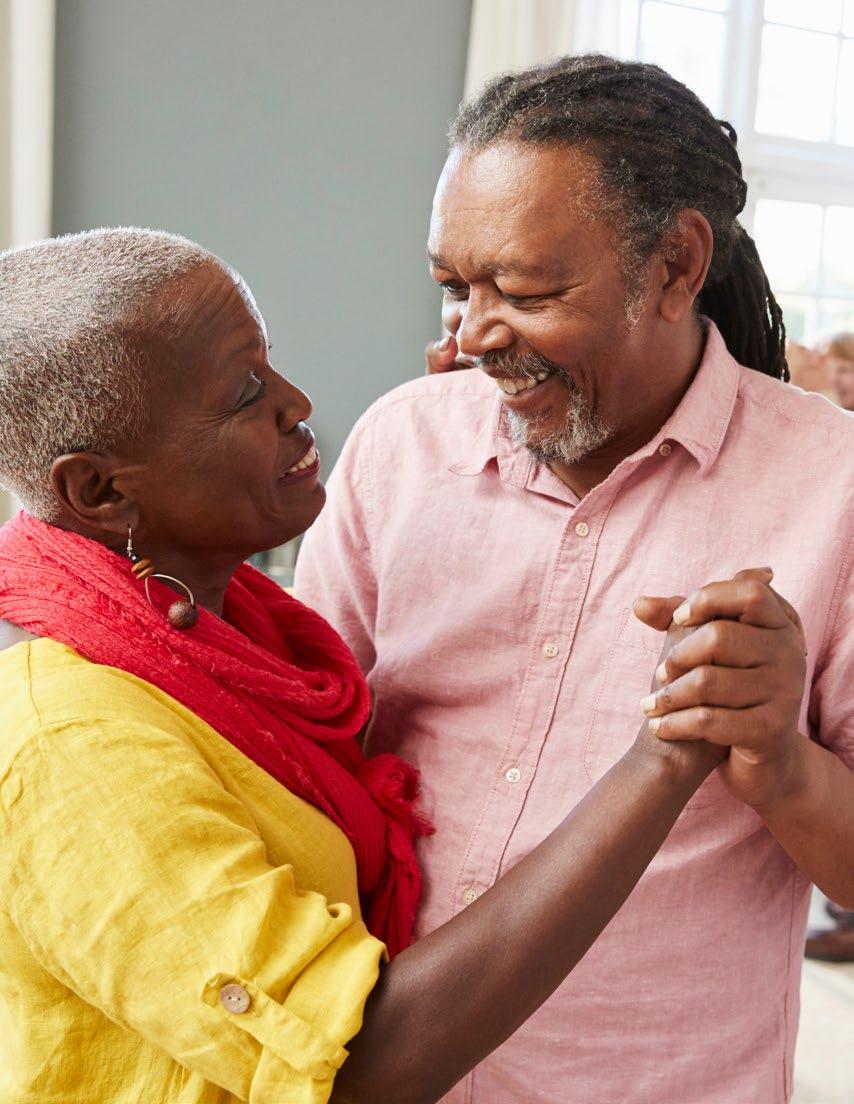

Inclusive Communities
DESIGNING PLACES WHERE PEOPLE FEEL THEY BELONG
As we progress through our lives, community often happens organically. It gets built around our siblings, our elementary school soccer teams, the high school band, the neighborhood basketball court, a college dormitory, shared classes, the office lunchroom, our kids’ ballet and art lessons, or the local dog park. But as people transition into the third act of their lives and often away from these ingrained patterns of communal gathering, how can we recapture that sense of belonging in a new place?
Defining a Shared Language
The following definitions are adapted from the American Institute of Architects (AIA) Guides for Equitable Practice and the Cornell Diversity and Inclusion Certificate Program. These were developed in the context of the workplace and have been lightly edited for applicability.
Diversity: A mix of people with a wide range of visible and invisible personal and group characteristics, backgrounds, experiences, and preferences. This can also include differences between building industry disciplines, the aims and agendas of firms, or roles on a project team.
Inclusion: Creating an environment where everyone is welcomed, respected, supported, and valued. It relies on mutual adaptation through which differences are embraced and negotiated.
Equity: The state in which everyone is treated in a manner that results in equal opportunity and access, according to their individual needs. Equity in the workplace requires identifying and eliminating barriers that have disadvantaged nondominant identity groups to assure that all individuals receive equitable treatment, opportunity, and advancement regardless of identity; it also means that some individuals will need more support than others.
Belonging: The feeling that a person has that they are a valued part of a group. This can be considered the inverse action of Inclusion. Where Inclusion is the series of actions and decisions taken to bring people in, the sense of Belonging is the resultant collection of emotions that proves the Inclusive strategies have taken hold.
Equality: Equality is a form of fairness achieved by treating people with dominant and nondominant identities in the same manner, whatever the disparities may be at their starting points. Equal treatment, however well-intentioned, may sustain inequities. The term is often used in contrast with equity.
Justice: Justice, or social justice, denotes the assurance of fair treatment; equal economic, political, and social rights; and equitable opportunities and outcomes for all. It also encompasses a repairing of past wrongs, transformative justice, and accountability.
Exposing one’s authentic identity is at the heart of finding community and sense of belonging. But when that identity comes with perceived risks, community can be much more difficult to find. Particularly for people who identify as LGBTQ, finding community is not always so straightforward. On April 22 of this year, The New York Times featured an article on SAGE, an LGBTQ advocacy group that specifically supports mature adults by connecting them to housing, services, healthcare, and cultural programming. Housing is a critical issue for LGBTQ people. A 2018 survey of people over the age of 45 who identified as LGBT revealed that 34 percent are worried they would have to hide their identity to gain access to suitable housing, and a recent study from UCLA reported that sexual minority adults are twice as likely as the general population to experience homelessness.1 Finding acceptance in a community can be more than just a comfort. The Times article profiled one new resident of Stonewall House, a SAGE housing development in Brooklyn, who finally found stable housing after a lifetime of struggle. “There are people like me in this building,” she said.
Finding “people like me,” can be challenging for aging adults from any demographic group. According to the 2020 US Census, the United States is more ethnically and racially diverse than ever before in history.2 We often gravitate to those who look and act similarly to ourselves. But as the Othering and Belonging Institute at The University of California, Berkeley, explains, finding community is not as simple as finding other people who look like you. A sense of belonging comes from “having a meaningful voice and the opportunity to participate in the design of political, social, and cultural structures.” Or in this case the right to both contribute and make demands upon a community where they live.
Generally referred to as “The Big Eight” identities, these categories are often expanded to include characteristics such as appearance, marital status, political ideology, and education.
Belonging is increasingly being added to the series of terms companies and organizations are using to better understand how people identify, interact, communicate, and build relationships. The concepts of diversity, equity, inclusion, and belonging are critical to building communities around shared values and desired outcomes, often unrelated to skin color or sexual orientation.

Priya Living
BUILDING COMMUNITY AROUND HAPPINESS AND CULTURE
“Life is Better, Living Together” is the motto for Priya Living, a senior living provider that focuses on culture and community. With its roots in the Indian diaspora, Priya Living looks to “build culture in a way that transcends culture,” according to Arun Paul, Priya’s CEO. Priya’s first communities began as safe spaces for those with a shared cultural identity to live, wanting to ensure no one was lonely. A 2020 study by the National Academies of Sciences, Engineering, and Medicine found that 25% of people over the age of 65 feel socially isolated.3 Many times, this is higher in minority populations. Loneliness has been attributed with many increased health risks, such as depression, heart disease risk, and dementia. Ensuring that residents are not lonely is a big part of Priya’s mission.
Initially, Priya did not provide many amenities to its residents. Priya positioned its first properties adjacent to cultural infrastructure, drawing residents in, while also providing access to amenities that did not yet exist within the community, such as culinary service. The communities have since grown, now having multiple locations across the country, and so have the amenities. The culinary program, heavily influenced by the traditionally vegetarian diet of India, continues to expand. This has been a draw for not only the Indian diaspora, but also for residents interested in a plant-based diet. Offering a variety of separately packaged proteins, residents can personalize their meals while still being respectful of others’ choices. Priya is also looking at more flexibility in their dining program,

Setting New Industry Standards
LeadingAge, the market sector’s primary representation for nonprofit aging services providers has embraced diversity, equity, and inclusion in their programming and conversations, reflecting the importance of these issues to their membership. Recently, LeadingAge established a DE&I Council within the organization and formulated a Diversity, Equity, and Inclusion Group on the website that invites members to collaborate and share stories about how they are integrating DE&I practices in their organizations.
At the recent Leadership Summit in April 2022, several sessions addressed DE&I directly, and the thread continued throughout other sessions. Sessions that featured DE&I topics included:
2-A. Aligning Organizational Values and DEI: Challenges and Opportunities
11-B. Building a Diverse Workforce Pipeline One Intern at a Time
18-D. Inclusive Leadership: Leveraging Our Roles to Create Cultures of Empathy, Trust and Belonging
25-E. Creating A Diverse, Inclusive, and Equitable Workplace Culture
29-F. Creating Pathways of Advancement for Employees of Color

as not everyone wants to sit down to dinner in a dining room every day of the week. Having access to food throughout the day, along with grab-and-go options, allows for more individual choice. Providing choice and flexibility helps to bridge between a single cultural group or individual preference and a larger community.
Perkins Eastman is currently working on several projects with Priya. The Rochester Hills project in Michigan just completed construction documents and hopes to start construction early this Fall. For Priya’s new communities, community partnerships are critical to the success and happiness of their residents. Similar to how cultural infrastructure was utilized by their first properties to support the needs to the community, Priya continues to build community partnerships that foster social connection. Whether it be through a religious service, art classes with local high schoolers, or laughter yoga, bringing people of all ages and backgrounds together helps build empathy, joy, and compassion.
The Chai Bar and Market offers a “taste of home” with traditional Indian food and drink. It’s a place to gather together with friends and family in the creation of community.
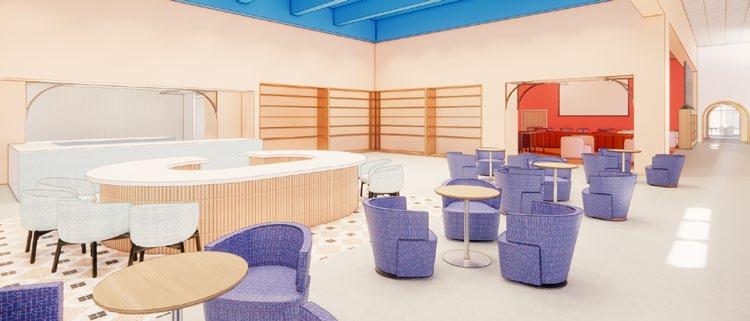
The Masti Lounge is a place to relax and have fun in a casual setting. Residents may enjoy music and Bollywood films, and other group activities.
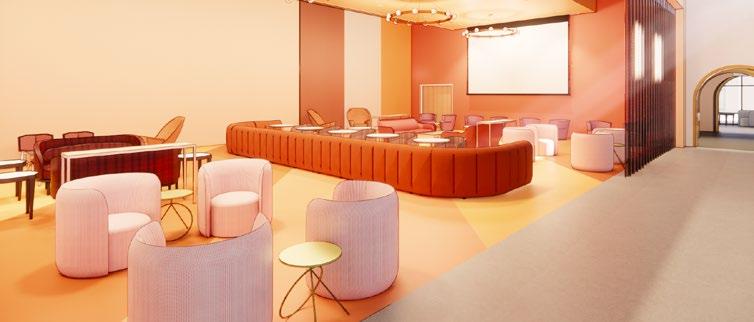
A modern and familiar space, the resident courtyard will offer pops of color to bring joy and surprise to this garden.
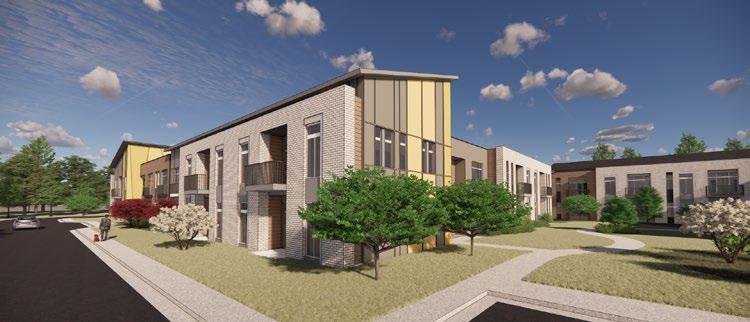

The Connector building will literally “connect” the two pieces of the Newton community, bringing together the existing community of Coleman House and the new moderate-income apartments at Opus. The generous terrace adjacent to the main spaces allows gathering to flow from inside to outside.

2Life Opus | Newton
KIBBUTZ, NOT CRUISE SHIP
Long-term relationships are central to the work Perkins Eastman delivers. Our collaboration with the leadership at 2Life Communities supports a joint effort to translate their mission—to demonstrate new, creative ways to support aging in community through affordability, connection and purpose, and innovation—into thoughtful, humancentered design.
For years, Amy Schectman, the CEO of 2Life, has described their work as building an older adult “kibbutz”. This model of community building centers around the intentional and integral relationship of residents to everyday activities and the vibrant life of the community. She pits this model against that of a cruise ship, a service-heavy place in which one’s every whim is catered to. Not only does the kibbutz model decrease operating costs, allowing for folks in more middle-income ranges to live here, but in early focus groups, those folks were eager to engage in the life of the community in meaningful ways. An innovative concept in older adult housing was born of this idea -- the Opus Community.
Co-located with Coleman House, one of 2Life’s existing low-income communities, the new apartments at Opus—Newton will fill a current gap in the adult housing market with apartments that are affordable for more moderate incomes. These independent living apartment buildings will occupy the same site in Newton, Massachusetts, just outside of Boston. The Coleman House is a mostly 5-story low-income older adult housing apartment building comprised of 146 affordable independent living apartments. Over the past several years, Coleman House has been getting a facelift. Renovation work includes new windows, an updated design to the brick facade as well as updates to the mechanical and sprinkler systems and interior finishes. The apartments will undergo significant renovations to the kitchens and bathrooms which are geared towards added maneuverability and flexibility.
After this renovation is complete, the entirely new Opus Building will be built. The Opus apartment building will offer 174 independent

The new Opus apartments (right) are joined to the existing Coleman House apartments (left) by the Connector (center).
Designing for Flexibility
Joining the two residence buildings is the Connector, a two-story light-filled building containing a series of highly flexible gathering spaces to accommodate a variety of social, culinary, and fitness needs. By connecting the two residential buildings through the amenity space, it will encourage residents, staff, and visitors to form a larger community that breaks down the barriers of income and class, leading to a more equitable community.
This series of design studies by our interiors team illustrates the many ways the amenity spaces in the Connector building can flex to accommodate a variety of activities, greatly reducing the amount of space needed overall.


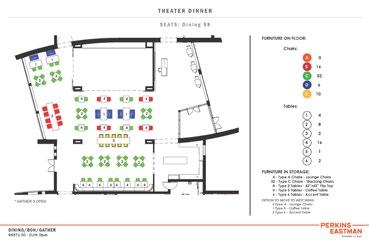


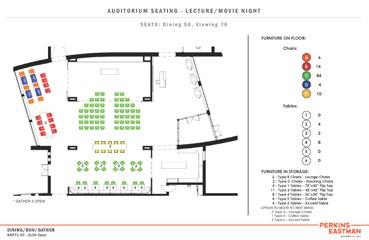


living residences in six stories over two stories of parking. The exterior is designed to settle into the landscape with wings stepping down and softening at the edges to relate to the context around it. Variegated siding colors and patterns recall the fall foliage that surrounds the site in the autumn months. A masonry base speaks directly to the geology and geography of New England. Joining the two residence buildings is the Connector, a two-story light-filled building containing a series of highly flexible gathering spaces to accommodate a variety of social, culinary, and fitness needs. By connecting the two residential buildings through the amenity space, it will encourage residents, staff, and visitors to form a larger community that breaks down the barriers of income and class, leading to a more equitable community.
Sustainability should be considered an aspect of building inclusively. Our relationship to the earth and respect for nature requires us to think holistically about how we use resources
and occupy the land. On this project, Perkins Eastman has the benefit of working with clients who are already well-versed in and committed to sustainability on multiple levels. The new construction Opus building will be designed to LEED Gold and Passive House standards. The Coleman renovation will seek WELL Certification and Enterprise’s Green Communities certification, a nonprofit certification that addresses America’s affordable housing crisis through the goals of increasing supply, advancing racial equity, and building resiliently. A PV solar array will cover the roofs of both apartment buildings, and numerous electric car charging stations will be located in the garage at Opus. The design incorporates economic sustainability in its ratio of low- and middleincome, modest-sized apartments with flexible amenity space. The location for the new building was selected in order to capitalize on existing development within a vibrant community.
The interior of the Connector is a flexible series of gathering spaces that supports dining, lounging, small group discussions, and large community events.
IDEAS: Inclusivity Starts with the Process
Many communities for older adults consider DE&I to be a cornerstone of their brand. Being welcoming and inclusive is important for attracting new customers, but is also at the heart of many communities’ missions. A critical way to ensure that people feel a sense of contributing meaningfully to their communities is to involve them in the decision-making process. This can be particularly crucial for communities undergoing or considering change through a master planning process.
For nearly 15 years, we have been using an inclusive process that aims to build consensus with multiple stakeholder groups. Based on traditional community engagement methods, the IDEAS process integrates design, economics, and assessment of existing facilities into a strategy that communities can use to holistically study an appropriate approach to moving forward. The process incorporates a community’s own mission and is inclusive in its focus on the residents, staff, leadership, and governance structures that encompasses a “community.”
To further support the inclusive intention, we include a diverse group of thought leaders and planners on our side to ensure a variety of perspectives is considered. This diversity spans across generations, genders, ethnicities, and experience levels. We also incorporate varying types of technology to best engage stakeholder groups and capture the data necessary to help clients make informed decisions.
The IDEAS process is inherent to our mission of emphasizing diversity, vitality, and conscious inclusion as essential components of our work life, and embodies the very essence of what it means to be Human by Design.
+ Challenges
Throughout the design process, we have strived to ensure the existing Coleman residents are included in design decisions and understand project outcomes. The residents of the Coleman House are primarily Russian, Chinese, and English speaking. Through working with the 2Life Communities translator, summary design documents of the Coleman renovations and Opus preliminary design were provided to the residents in all three languages.
One of the innovative features of Opus—Newton will be a volunteer program initiated by 2Life. To keep operating costs to a minimum and to encourage involvement in the life of the community, each resident will perform a certain number of service hours per month in an activity of their choosing. The building design is responsive to this unique component through clear circulation paths, moments for pause and small gatherings, and volunteer stations that will support these activities. Every aspect of this project was designed for active adults to age in community while contributing to the vibrancy and social life of the place that will encourage everyone to feel that they belong.
Discussion Starters
How can communities be inclusive of different backgrounds, lifestyles, and cultures while staying true to the mission of the organization?
As the United States moves toward becoming a “minority majority” country, how can communities appeal to a more diverse set of consumers who may be looking for a variety of options and outcomes?
What does it mean for an organization to “build culture in a way that transcends culture?”
Baby Boomers are looking for a “Third Act” that will align with their social and cultural values as well as their wallets. What can communities do to attract this social justice-minded cohort to a particular place?
When looking at the continuum of care, are there ways in which inclusivity manifests differently along the continuum? What may be different for an active adult community versus a memory care environment?

Sample design selection board with English, Russian, and Chinese text.

Integration with the landscape is a primary focus of the Opus community. Native plants cover the terrain between a series of walking paths and the building foundations to invite residents and visitors to experience the natural environment.
A Note from the Authors
As we began researching this paper, we reflected on our own multifaceted identities and how those might inform this project going forward.
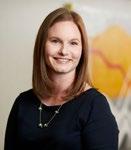
Brianne Johnson Pham AIA
Senior Associate
San Francisco
+1 650 497 6306
b.pham@perkinseastman.com
I am seven-sixteenths Swedish, one-sixteenth Norwegian and the rest is a European mix. I then married someone who is 100% Vietnamese. Looking at my daughter, within 3 generations, my grandfather’s 100% Swedish heritage has become a beautiful blend of cultures, traditions, and backgrounds all with varied histories. Because of this mix, I jump back and forth between cultural groups depending on where I am and who I am with, catering my story to be included and feel like I belong.
Resources
Othering and Belonging Institute (UC Berkeley)
SAGE NY Times Article
AIA Guides to Equitable Practice
Endnotes

Emily Pierson-Brown AIA
Senior Associate
Pittsburgh
+1 412 894 8323
e.pierson@perkinseastman.com
I am about one-quarter Swedish, one-quarter English-German mix, and the other half is some combination of Syrian, Egyptian, and other Middle Eastern heritage. My wife is a Black woman whose ancestry in this country is longer than mine, but ultimately less well-known due to the injustices of American history. I am often the only white person when we spend time with her family and Jamaican godparents; she is the only Black person when we gather with the Piersons. We are the only gay couple in either family. We each shift our understanding of “belonging” based on who we are with and the shades of our identities that help us relate to those people.
1 Wilson, B. D. M., Choi, S. K., Harper, G. W., Lightfoot, M., Russell, S., & Meyer, I. H. (2020, May). Homelessness among LGBT adults in the US. UCLA School of Law Williams Institute. Retrieved June 1, 2022, from https://williamsinstitute.law.ucla.edu/publications/lgbthomelessness-us/
2 Jensen, E., Jones, N., Rabe, M., Pratt, B., Medina, L., Orozco, K., & Spell, L. (2021, August 12). The chance that two people chosen at random are of different race or ethnicity groups has increased since 2010. Census.gov. Retrieved June 1, 2022, from https://www.census. gov/library/stories/2021/08/2020-united-states-population-more-racially-ethnically-diverse-than-2010.html
3 National Academies of Sciences, Engineering, and Medicine. (2020). Social Isolation and Loneliness in Older Adults: Opportunities for the Health Care System. Washington, DC: The National Academies Press. https://doi.org/10.17226/25663.
Image Credits
Page 1: Adobe Stock, © stockyme
Page 2: Adobe Stock, © Alberto
Page 4: Adobe Stock, © Monkey Business
Page 8: Adobe Stock, © rawpixel.com
Page 9: © Perkins Eastman
Page 10: © Perkins Eastman
Page 11: © Perkins Eastman
Page 12: © Perkins Eastman
Page 13: © Perkins Eastman
Page 15: © Perkins Eastman
Page 17: © Perkins Eastman

Alejandro Giraldo AIA
Principal + Practice Area Leader
+1 203 251 7435
a.giraldo@perkinseastman.com

+1 412 894 8366
e.chmielewski@perkinseastman.com

Brad Fanta CPSM Senior Associate, Marketing
+1 737 273 3814
b.fanta@perkinseastman.com
www.perkinseastman.com
